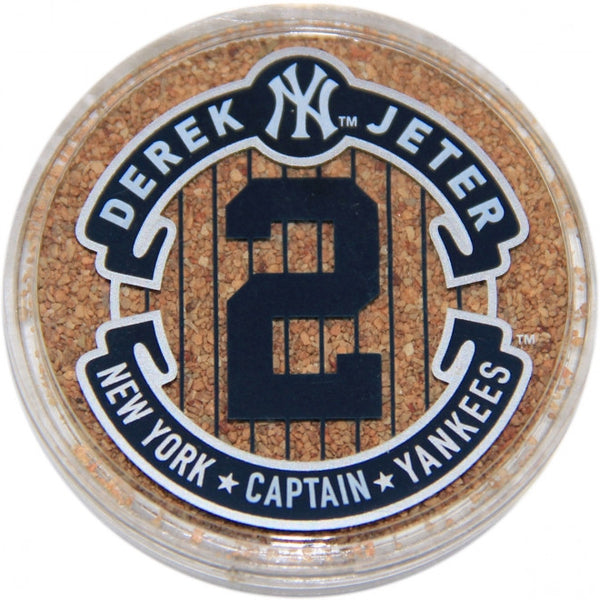With the dust settled on Derek Jeter’s glorious baseball life, it’s time to celebrate his dirt. Steiner Sports is selling capsules of “incredible” infield dirt from the sure-fire, first-ballot Hall of Famer’s last game at Yankee Stadium on September 25th, 2014. “Take home your own piece of history with this one time offer,” says the description on Steiner’s website. “This dirt is guaranteed authentic by MLB Authentication.”
Since early September Brandon Steiner, CEO of Steiner sports memorabilia has been in the news a lot lately. In a lengthy profile, headlined “The Man Who Spins Pinstripes Into Gold,” the New York Times reporter Richard Sandomir explored how the “sports memorabilia maven’s ability to see a deep fan-athlete connection in even the most overlooked items has made him an outsize figure in the business and a key figure in the selling of Jeter’s final season with the Yankees.” A 13-part slideshow showed him delivering a base from a game to a customer in the stands between innings and even inspecting the groundskeepers’ rakes for sale.
By the time of Jeter had taken his last swing, Steiner had become a piñata. The New York Daily News columnist Bob Raisman ridiculed him as “Jeter’s designated memorabilia schlepper.” The town’s other tabloid, the New York Post, harped on the biggest symbol of wretched excess, $409.99 game-used Jeter socks. “You can look at the sock tongue-in-cheek and take a shot at it, that’s fine,” Steiner shot back. “No one is forcing you to buy the sock, or a jersey. People want to get connected to the players they love.” At that point, Steiner appeared to have had it with the press. When ABC News called him a few days later he “declined to comment.”
He’s right: No one is holding a gun to your head. And if owning a little piece of their idol gives hero-worshippers pleasure, they should go for it. On top of that, in a hobby filled forgeries peddled by unreputable dealers, Steiner’s transparent chain of custody from the stars to collectors is above reproach—whether you buy from him on the web or go to one of the shows where he has booked one of his exclusive stars such asMariano River, which I covered in an earlier post. “I have purchased from Steiner in the past,” wrote Mike Shepherd on Autograph Magazine Live’s forum. “You can sleep well at night know that the item is authentic. I could have a lot more autographs in my collection if I purchase from someone or somewhere else, but I would always have a little doubt about authenticity.”
Nor does Steiner receive much credit for selling products at every price level. The capsules of Jeter dirt start at 9.99 (plus $4.99 for shipping and handling). He even offered them free to the first 222 customers who entered a promo code. My only quibble is that the limit of one per customer suggests a finite quantity. Presumably, it would be possible to dig miles below the Yankee infield for more.
And all the shock and dismay about the dirt seems, well, a little ungrounded. Steiner’s site has been selling various versions of dirt for some time; there are 26 pages of it for sale on its site. For months bidders on eBay have driven the price as high as $499, for a framed Steiner poster collage of Jeter with game-used dirt. At the same time,as I wrote in my last post, Steiner refuses to “go on record” hyping his products as sound investments.

Furthermore there’s a rich history of baseball dirt. Twenty five years ago Joshua Evans, the founder of Lelands sports auction house, paid $500 for a vial from Ebbets Field. “On the day there was a garage sale at Ebbets Field in 1960 Paul Hill, an early, great collector walked down on the field and scooped up dirt,” says Evans. “He had this elaborate vial created with the date he got it and the writing professionally imprinted. And he created a little wooden stand like you would make in a woodshop, all painted and varnished. It was great folk art.”
Suffering remorse, the seller, who had acquired it directly from Hill, failed to buy it back from Evans for $600. “But [the story] ends sadly,” Evans told me. “One day I was in my house and all I saw was the little wooden stand on a shelf with no dirt vial. I confronted my housekeeper and she sheepishly confessed she had broken it while cleaning and had thrown it away. I tried to explain to her in her second language, English, that this was sacred dirt, but she looked at me kind of like a dog does when he sees his reflection in the mirror. And I told her, in no uncertain terms, that in the future when she breaks something she should save all the pieces when I get home.”
Evans has since sold dirt from actual players a few times. Mets fans popularized the collecting trend after the team’s 1969 World Series championship, storming the field to rip up grass. “My [boyhood] friend Marshall Rosen planted his Mets sod in the backyard,” Evans says. “I remember asking him which patch it was.”

In one of my periodic fits of collecting insanity, I got swept away in the Cal Ripken hoopla after he broke Lou Gehrig’s record of consecutive games played. While reporting a travel story about baseball and Baltimore in 1996, I visited the Babe Ruth museum. In the gift shop I bought a limited edition Ripken Fleer Ultra Diamond Dust Card from that year with soil from Camden Yards for $125. Today the cards sell on eBay for less than $20, but I still relish the cool souvenir and the happy memories of the trip with my dad.
--
This article originally appeared on Forbes.com on October 3, 2014: http://www.forbes.com/sites/davidseideman/2014/10/03/new-york-yankees-and-brooklyn-dodgers-game-used-dirt-is-worth-its-weight-in-gold/


